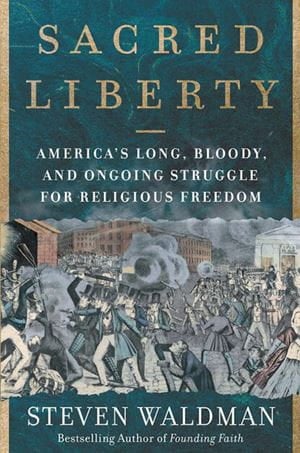
Religious freedom has become a big deal and a popular buzzword in recent years. Religious liberties have been attacked, and Americans have been forced to grapple with the fact that accepting religious freedom occasionally means allowing people to hold opinions with which they disagree. What was once an accepted part of American society has become a political circus.
In such times, it can be more important than ever to look to history for advice and for warnings. Steve Waldman, however, suggests that the history of religious freedom in America is not as simple as many people believe.
“I felt like there was so much misinformation about what religious freedom was and how we got it,” Waldman, co-founder of Beliefnet, said. “[I believed that] having the proper history of how we ended up with religious freedom would be helpful right now. It has a kind of urgency to it that I didn’t expect given how controversial religious freedom has become.”
One of the biggest pieces of misinformation, Waldman said, was when precisely religious freedom truly appeared in America.
“We don’t have religious freedom just because of the Founding Fathers,” Waldman said. “We have it because of the blood and the fights of regular Americans over the next 200 years.”
Chronicling that fight and the myriad of ways that religious freedom was threatened and had to be redefined as time changed became the basis of Waldman’s book “Sacred Liberty: America’s Long, Bloody and Ongoing Struggle For Religious Freedom.”
To the surprise of some readers, no doubt, the book begins long before the independence of what would come to be the United States of America was even a distant possibility.
“I started pretty much when Europeans started to settle in America, Waldman said. “I suppose I could have started with the Constitutional period, but the 150 years before the Constitution were really important. America tried different models of religious freedom back then, and they were mostly horrible failures. We had colonies with official state religion, and we did have theocracies in America. They didn’t work so well. That history is part of why the Founding Fathers…changed directions and approached [religious freedom] in a different way.”
The decision of the Founding Fathers to aim for true religious freedom was extraordinary. Putting their high ideal into practice, however, was something that everyday Americans struggled with for generations. “America hasn’t had true religious freedom for most of its history,” Waldman argued. “We tend to think we had it from the beginning, that it’s why the Pilgrims came and because it’s in the First Amendment, but that’s not true at all. We had very little religious freedom in the beginning, and it only developed gradually because of the conflict and sacrifices that people made in the 18th, 19th and 20th centuries. It’s a little like Civil Rights for blacks, you don’t look at the Declaration of Independence and say it declared all men equal so blacks were equal. It took a few hundred years for that to happen. The same is true of religious freedom. It took centuries of Americans demanding these rights for religious freedom to become real.”
Given the massive timespan that the book covers, Waldman picked a handful of specific events and conflicts to focus on in “Sacred Liberty.”
“[The event] had to illustrate a key theme or act as a turning point [in the discussion or implementation of religious freedom],” Waldman said. “So, for instance, why the Jehovah’s Witnesses? They’re not a particularly large religion in America, but they have a whole chapter. The reason is that the serious persecution of the Jehovah’s Witnesses in the 20th century lead to a series of Supreme Court cases that forever altered how we approached religious freedom….[The Jehovah’s Witnesses] took [the issue] to court, which was different from what happened in the past, and they demanded their rights under the First Amendment. It was at that time in the 1940s that the Supreme Court started to shift. It said the Jehovah’s Witnesses were right, and if the First Amendment is to mean anything, it must protect people like them who have unpopular religions.”
That fight to protect all religious, even those that have ideas that may not be popular, continues today. “Religious freedom is one of America’s greatest inventions,” Waldman said, “and I do feel that it is in jeopardy… If we don’t wake up and realize what religious freedom is, we could easily squander what we have achieved.”
Walderman makes the point that America has come a long way from its early attempts at implementing what was once seen as an impossible ideal. “[For centuries,] if you wanted to support religion you should have the government do it. Through modern eyes that seems kind of horrifying, so un-American that government should be funding religion…but it was the norm for most of world history… That makes you appreciate how dramatic, radical and counterintuitive it was for the Founders to say, ‘The best way to promote religion is to leave it alone,’” Waldman said. “We’ve come to consensus [by now] about most of the key points [of the Founding Father’s original plan.] The government doesn’t favor one religion over the other. Persecution of one religious group over another is viewed with horror and is illegal. There are a lot of things that didn’t use to be true that are now true.”
Even more importantly, that protection was extended not just to private thoughts but to the right of people to live out their religion and practice it in the public square, regardless of whether it was popular or in line with the political correctness of the time. “For a long time, the belief was that the religious freedom protected your private beliefs but not your public actions,” Waldman said. “That began to change in the 20th century. For example, Seventh Day Adventists’ sabbath is Saturday. So, your state can’t say, ‘Tough. You have to work on Saturday.’ Instead, we’re bending over backward to accommodate people. People value religious freedom and religious pluralism so much that they are going to bend over backward to accommodate people and their religious beliefs. That’s very powerful. That’s a highly developed form of religious freedom… America has really figured out this model that allows for both tolerance and religious vibrancy. In other countries, you have either poor countries with one religion or these advanced Western countries that have secularism and no religious vibrancy. We are the only country that really has both. That’s a massive achievement in world history that we should be proud of and fight for.”
Unfortunately, that fight is likely to continue as people are forced to continue demanding and defending their religious freedom. The good news, however, is that America has fought this fight before and won. There is no reason this time should be any different.

